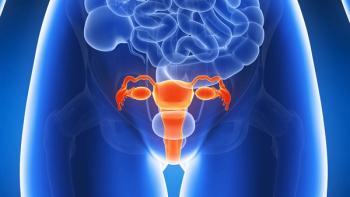
Older, Male Patients More Likely to Have CIP, Prospective Study Reveals
Data from a large prospective study identified male and older patients as being more likely to develop CIP and 34% of cases to become chronic.
Checkpoint inhibitor pneumonitis (CIP) is more common in male patients, older patients, and those treated with ipilimumab (Yervoy) plus nivolumab (Opdivo), and over one-third of cases became chronic, according to a large prospective analysis presented at the 2025 ESMO Annual Congress. The study evaluated CIP across patients receiving various combinations of nivolumab, with or without ipilimumab or chemotherapy.
Results presented by Jarushka Naidoo, MB, BCH, MHS, a professor of medical oncology and consultant medical oncologist at Beaumont Hospital, RCSI University of Health Sciences in Dublin, Ireland, revealed that 6.6% of male patients had CIP vs 4.9% of female patients.
Incidence by age was 8.5% in patients older than 75 years, 7.0% in those aged 65 to 75, and 5.2% in patients younger than 65. Among all cases, 34% became chronic, 8% were recurrent, and CIP progressed regardless of corticosteroid treatment.
The analysis included 11,777 patients from 25 phase 3 global clinical trials of nivolumab with or without ipilimumab, chemotherapy, or another agent, spanning nine solid tumor types. Overall, 716 patients (6.1%) developed CIP. The most common tumor types were non–small cell lung cancer (NSCLC; n = 2,654), gastroesophageal cancer (n = 2,276), melanoma (n = 1,910), and renal cell carcinoma (RCC; n = 1,323).
Among nivolumab combinations, the rate of CIP incidence was as follows:
- Ipilimumab plus nivolumab (8.0%; 305/2776)
- Ipilimumab plus nivolumab and chemotherapy (7.5%, 27/3580)
- Nivolumab (4.6%, 256/5517)
- Nivolumab plus chemotherapy (6.4%; 106/1639)
- Nivolumab plus another agent (4.5%; 22/487)
Severity and Management of CIP
Most CIP events were grade 1 (22.7%) or grade 2 (45.7%). Grade 3, 4, and 5 events occurred in 27.1%, 4.1%, and 0.4% of patients, respectively. Median time to onset for CIP of any grade was 17 weeks (range, 0.3–123.6), with 12.1 weeks for patients receiving ipilimumab plus nivolumab and 23.7 weeks for nivolumab plus chemotherapy. Time to onset was similar across grades. Median time to resolution was nine weeks for grade 1–2 events (range, 0.1–143) and 4.3 weeks for grade 3–4 events (range, 0.1–117.1), shortest in patients receiving ipilimumab plus nivolumab (6.3 weeks) and longest with nivolumab plus chemotherapy (14.8 weeks).
Treatment was held in 39.3% of patients with grade 1 events, 50.1% of grade 2 events, and 11.7% of grade 3 events; discontinued in 11.8% of grade 1 events, 29.2% of grade 2 events, 63.8% of grade 3 events, 81.2% of grade 4 events, and 66.7% of grade 5 events; and continued in 34.8% of grade 1 events, 4.5% of grade 2 events, and 0.9% of grade 3 events. Events occurred before treatment or in follow-up for 17.6% of cases.
“Reassuringly, 70% of pneumonitis events completely resolved,” explained Naidoo. “However, an important proportion, 22.5%, did not recover or resolve, and 4% were fatal.”
CIP was resolved in 62.9, 77.8%, 69.0%, and 40.6% of patients with grade 1, 2, 3, and 4 events, respectively. Events were not recovered or resolved in 34.2%, 19.4%, 17.8%, and 25%, respectively. CIP was fatal in all 3 grade 5 events as well as 0.5% of grade 2 events, 7.5% of grade 3 events, and 31.2% of grade 4 events.
Corticosteroids were used to treat 74% of any-grade pneumonitis, including 90% of grade 3 or higher events. Median initial corticosteroid dose was 1.13 mg/kg for any grade CIP and 1.39 mg/kg for grade 3 or higher CIP events. Median duration of treatment with corticosteroids was 7 weeks for CIP of any grade and 4.3 weeks when used in CIP grade 3 or higher. Median duration of corticosteroid taper was 5 weeks for events of any grade and 3.4 weeks for grade 3 or higher.
Second-line immunosuppression was used for the management of CIP in 3.4% of events of an grade and 8.7% of those grade 3 or worse. The most frequently used of these agents was infliximab (86%). Second-line immunosuppression was used in 21 patients with grade 3 or worse CIP/ In 26% of those cases, the issue was resolved/recovered or an end date was recorded; in 19.0% patients did not recover; and in 47.6% CIP became fatal. The median time to second therapy was 7 days.
Incidence of Recurrent and Chronic Pneumonitis
“There are 2 unique phenotypes of pneumonitis: recurrent pneumonitis…[which] is more common in men and those with RCC and HCC, and chronic pneumonitis, which can occur in up to 34.6% of patients,” said Naidoo.
The study identified recurrent pneumonitis, meaning a subsequent pneumonitis event without rechallenge after pneumonitis has been initially resolved, occurred as a pan-tumor event, rather lung cancer and melanoma, as previously thought.
Recurrent pneumonitis occurred in 8.5% of patients, with 69 total recurrent events. It was more common in White patients, patients with RCC (17.6%) and patients with hepatocellular carcinoma (HCC; 13.3%).
Most patients who experienced recurrence only had 1 recurrent event (91.8%), and the majority were grade 1 (25.7%) or grade 2 (40.9%); 28.8% were grade 3 and 4.5% were grade 4. Median time from first CIP event to recurrence was 6.1 weeks, and the median duration of recurrence was 5.1 weeks.
Overall, 8.5% of patients experienced recurrence (69 events), most commonly in White patients, RCC (17.6%), or HCC (13.3%). Most recurrent events were grade 1 (25.7%) or grade 2 (40.9%), with grade 3 (28.8%) and grade 4 (4.5%) events less frequent. Median time to recurrence was 6.1 weeks, with a median duration of 5.1 weeks. The majority of recurrent events (75%) resolved, with 3% not resolving and 4% fatal.
Chronic CIP, defined as lasting at least 12 weeks, occurred in 34.6% of cases, with most patients (94.5%) experiencing a single chronic event.
Reference
Naidoo J, Johnson D, Possick J, et al. Patient-level analysis of pneumonitis from clinical trials of nivolumab-based regimens in solid tumour. Presented at: 2025 ESMO Congress; October 17-25, 2025; Berlin, Germany. Abstract 2799O.
Newsletter
Knowledge is power. Don’t miss the most recent breakthroughs in cancer care.
















































































